Solar System Guide for Hitchhikers
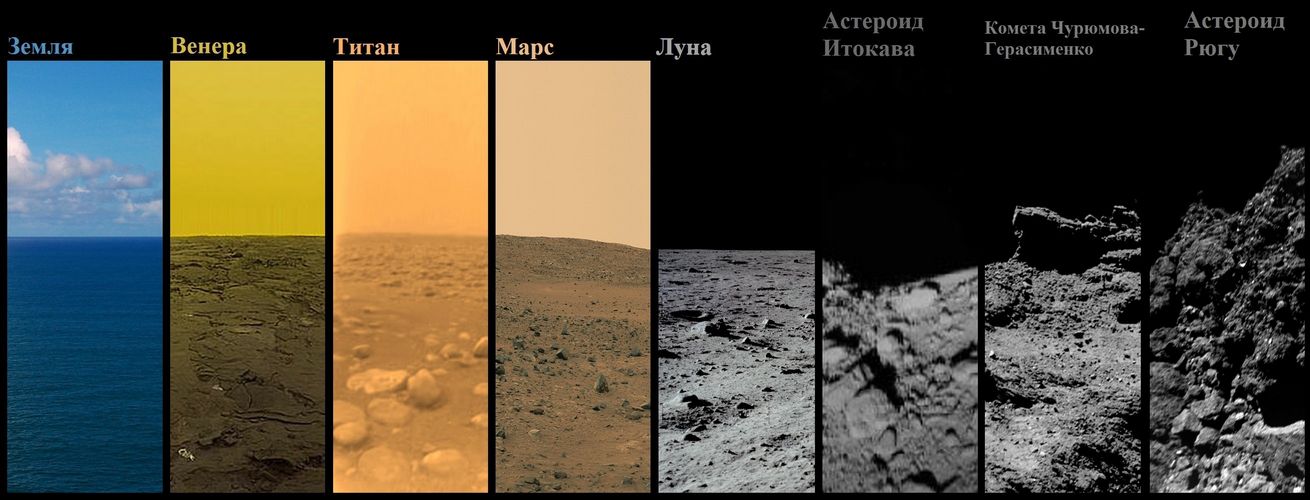
Images: Earth - Mike Malaska, Venus - Venus-14 (IKI RAS), Titan - Huygens (ESA), Mars - Spirit (NASA), Moon - Apollon-17 (NASA), asteroid Itokawa - Hayabusa (JAXA), comet Churyumova -Gerasimenko - Fila (DLR / CNES), asteroid Ryugu - MASCOT (DLR / CNES).
A man has always been attracted by uncharted distances - this is what allowed people to visit all corners of this planet and leave their traces on 83% of its surface. When the unexplored places on Earth ended, the pioneers took a fresh look at space - the very “last frontier” that promises us not only new knowledge, but immortality for humanity as a whole. And although people from all the celestial bodies of the solar system have so far been able to visit only one of them - the Moon - and even then in the person of only 12 of their representatives, the automatic probes have already visited 8 bodies , and 4 more have left their wreckage. Let us take a look at the conditions that all these probes recorded, the images, sounds and videos they received from places where lead melts, rivers flow from methane and alcohol is thrown into space.
Moon
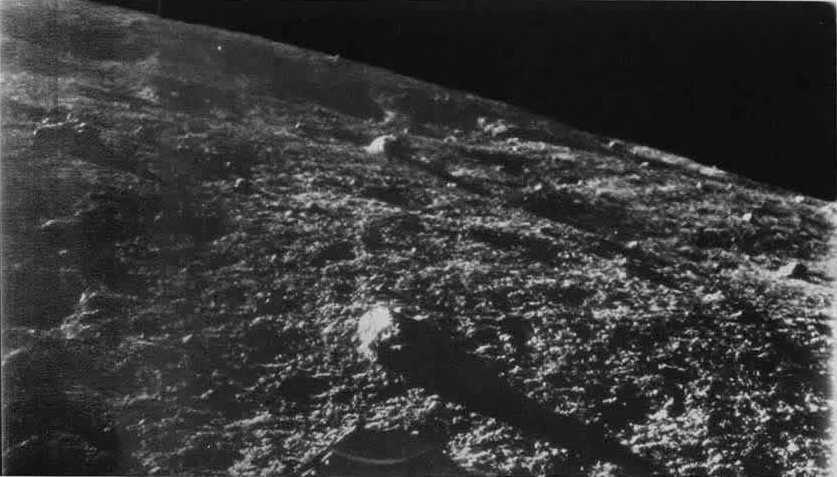
The first image from the moon’s surface was obtained on the Luna-9 landing platform on February 3, 1966 (click to view full panorama).
The Moon is the object of the Solar System closest to the Earth - closer to it only asteroids sometimes "wander". Not surprisingly, it was on the Moon that people visited, and close asteroids were for some time the next target for NASA, before setting off for Mars. But these missions were canceled in favor of the return to the orbit of the moon.
Initially, there were fierce debates in the scientific world about whether the moon had a solid surface, or whether it was covered with a multimeter layer of dust. There is even a legend that Korolev had to write the phrase “The moon is solid” in a notebook and sign in order to stop these disputes and, finally, to make an apparatus for landing on the lunar surface. And the legend is not far from the truth, only the text of the note in reality was somewhat longer:

After landing the first automatic devices on the moon, it turned out that the thickness of the dust on its surface is several times less than pessimistic estimates, so it was decided to abandon the intricate structures with inflatable balloons and expanding petals in favor of conventional supports of a small area. Automatic vehicles and the first manned missions captured the moon in a very boring place: monotonous gray slopes from small and large craters replaced each other, interspersed with placers of stones on the plains. In geological terms, the moon also turned out to be lifeless.
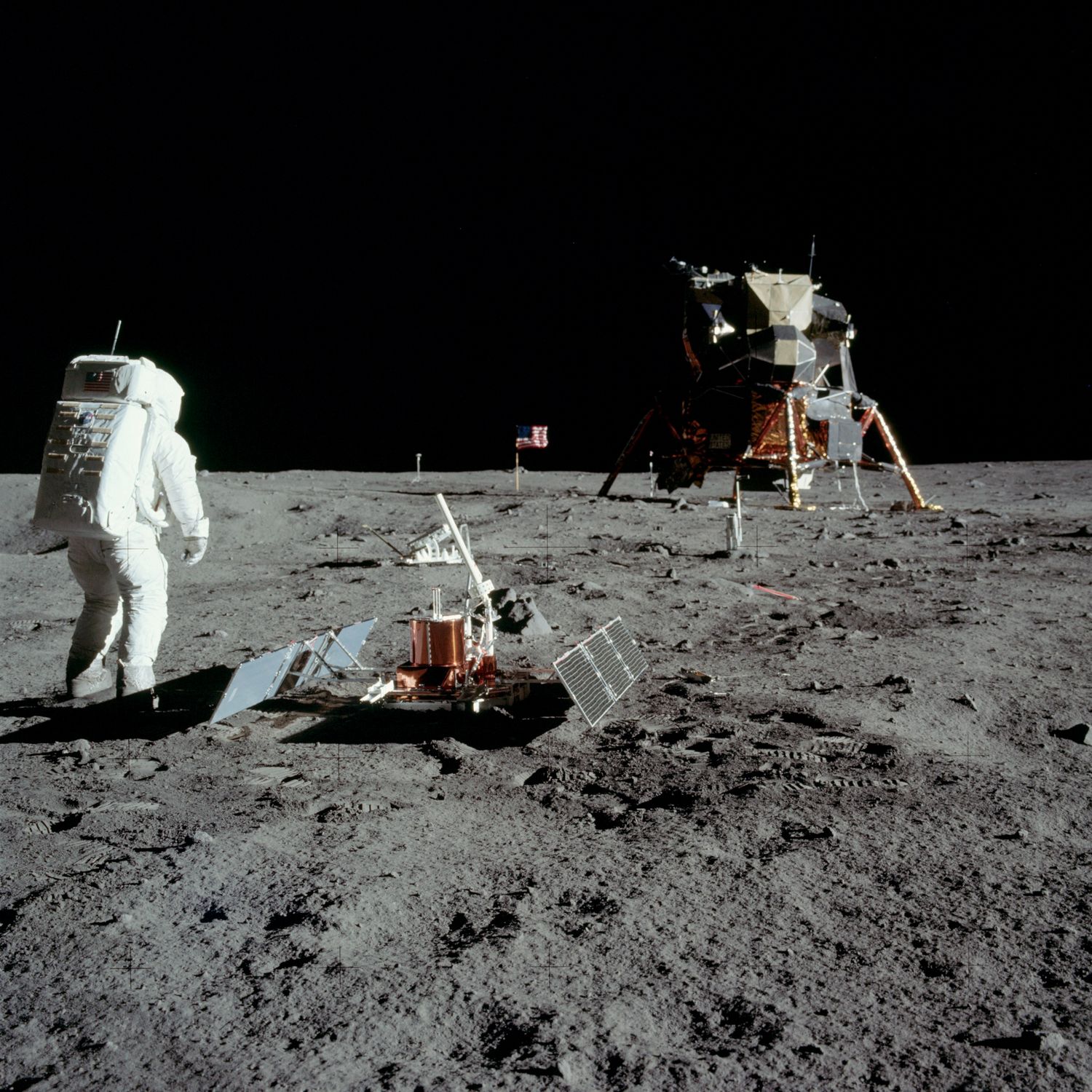
A picture of Buzz Aldrin during the installation of the first seismometer on the Moon, which during his work (from July 21 to August 25), he discovered about a hundred drops of meteorites, but not a single “moonquake”.
Only the last manned mission to the moon, and the only scientist who visited the moon as part of this mission, managed to discover something really interesting. This is orange soil , which spoke of the existence of volcanic activity on the moon in the past. Subsequently, similar traces of 18 million years old were discovered - “nothing at all” on the geological time scale. This allows us to argue that with a high probability of eruptions on the moon will occur in the future, but on the scale of human life they should not be counted on.
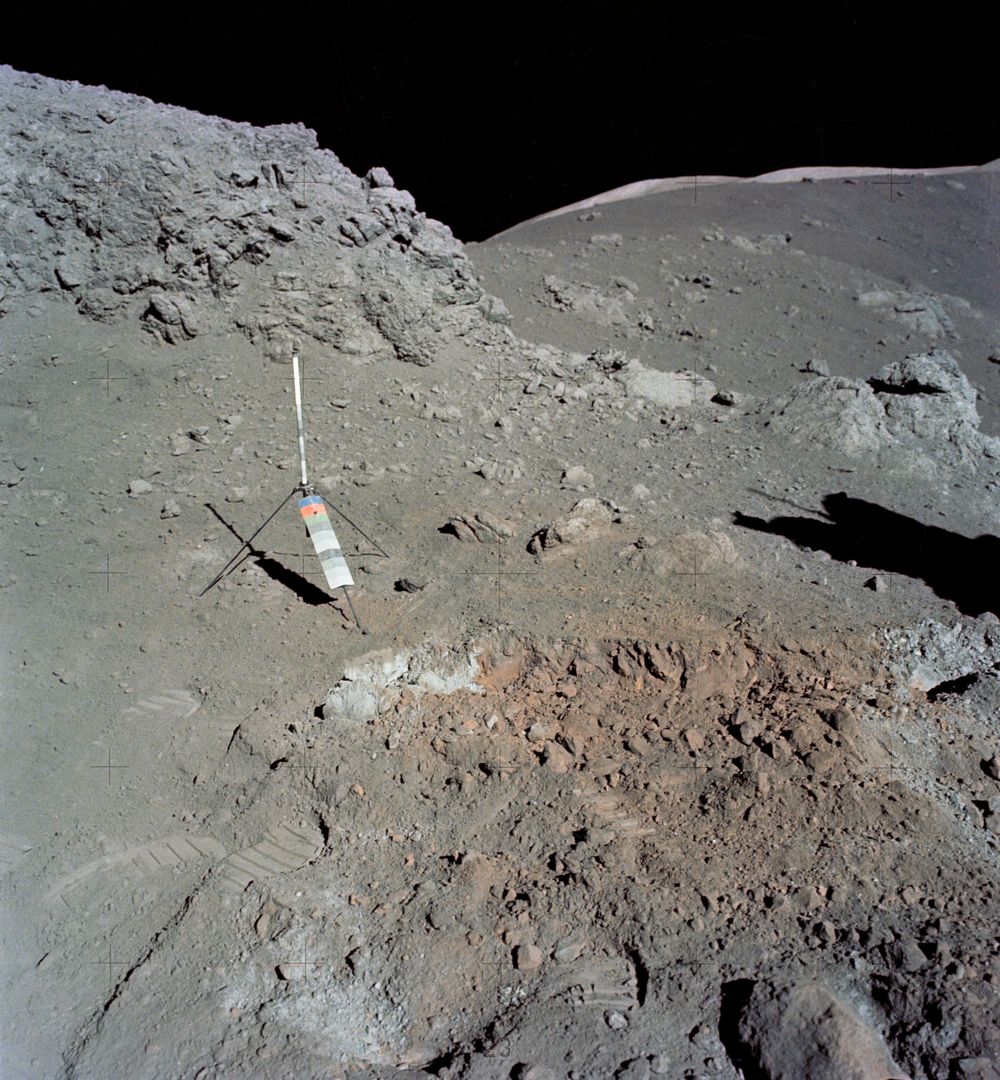
Lunar dust did not become an analogue of terrestrial "quicksand" , devouring landing devices as they were previously afraid, but, nevertheless, it carried a different threat: it turned out that the dust consists of very sharp and adhesive particles that easily stick to mechanical devices and caused their rapid wear. And what was even more important, they caused irritation of the lungs and skin, which astronauts complained about. Volcanic rocks cause the same effect on people on Earth, but here they are prone to rapid erosion, while on the moon due to the lack of atmosphere, these rocks do not lose their harmful properties for a very long time.
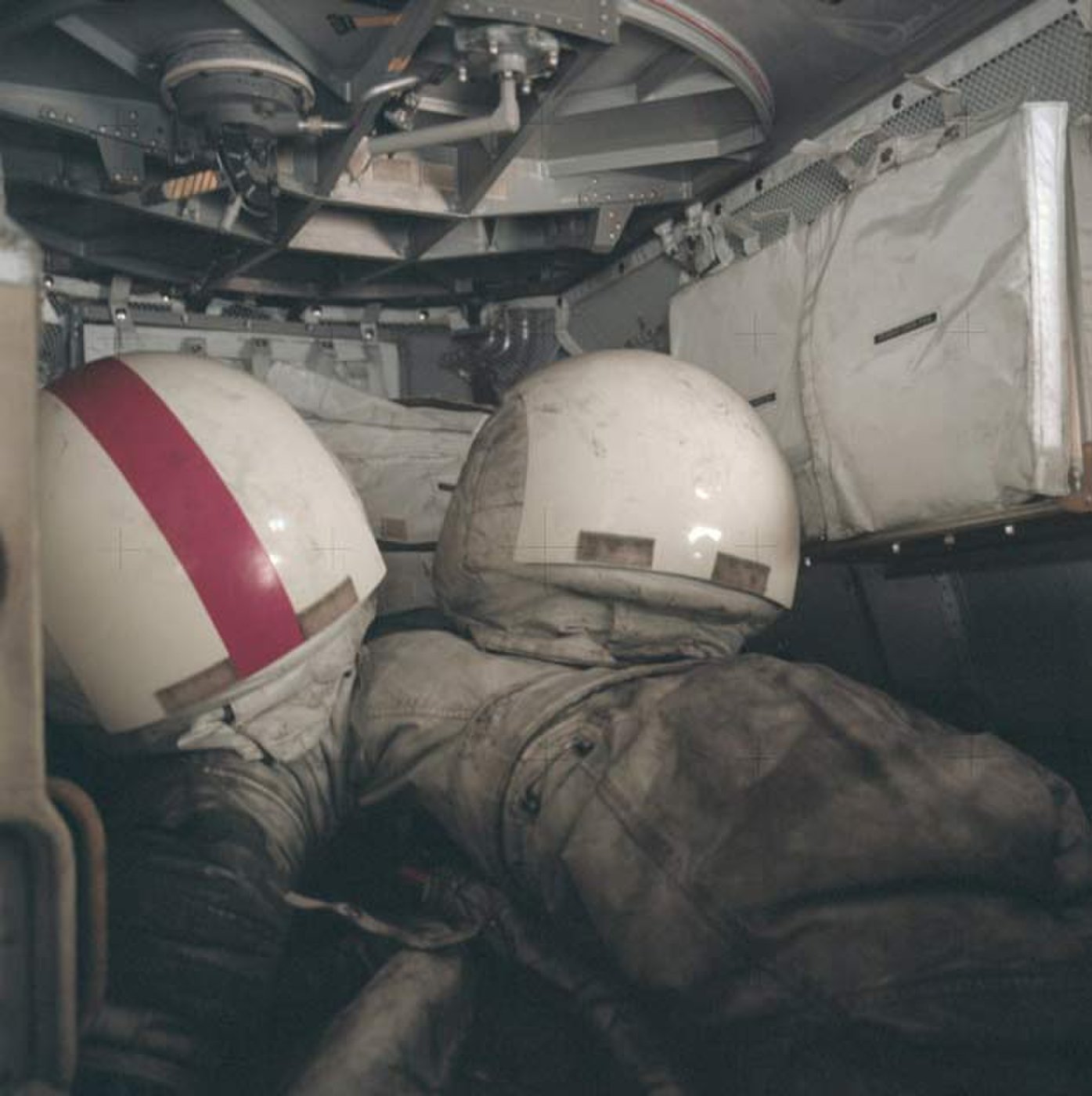
Suits of Apollo 17 after the third exit to the lunar surface.
But as they say “there is no silver lining”: a very interesting property was discovered in the moon dust: its particles during the lunar day gain electric charge under the influence of the ultraviolet radiation of the Sun and rise above the lunar surface under the influence of electric repulsion forces, forming a kind of “haze” in the region the horizon. This effect is considered the cause of the extinction of the corner reflectors of Lunokhod-1 and the gradual disappearance of astronaut traces in the images of the LRO satellite.
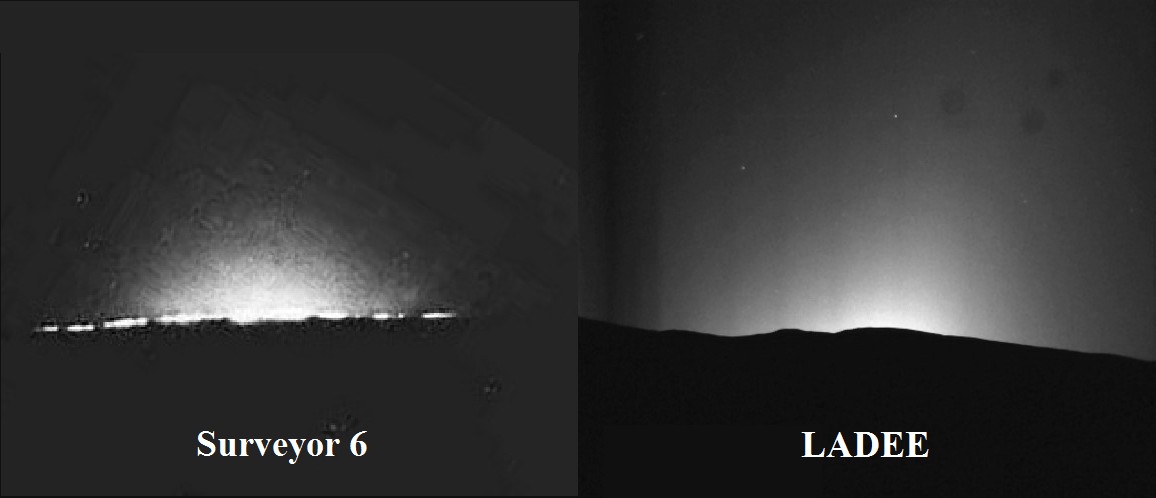
Photos of the terminator from the Surveyor-6 lander (1967) and the LADEE probe (2015).
And recently, the Indian apparatus discovered water ice on a satellite of the Earth. Although its concentration in the lunar soil is quite small, it is located at a depth of the order of a couple of meters and its amount (about 600 million tons) is not enough for serious industrial production, it can simplify the creation of a scientific station on the moon. Thus, although the Moon turned out to be a lifeless and not very hospitable place, from a scientific point of view it presented researchers with many surprises.
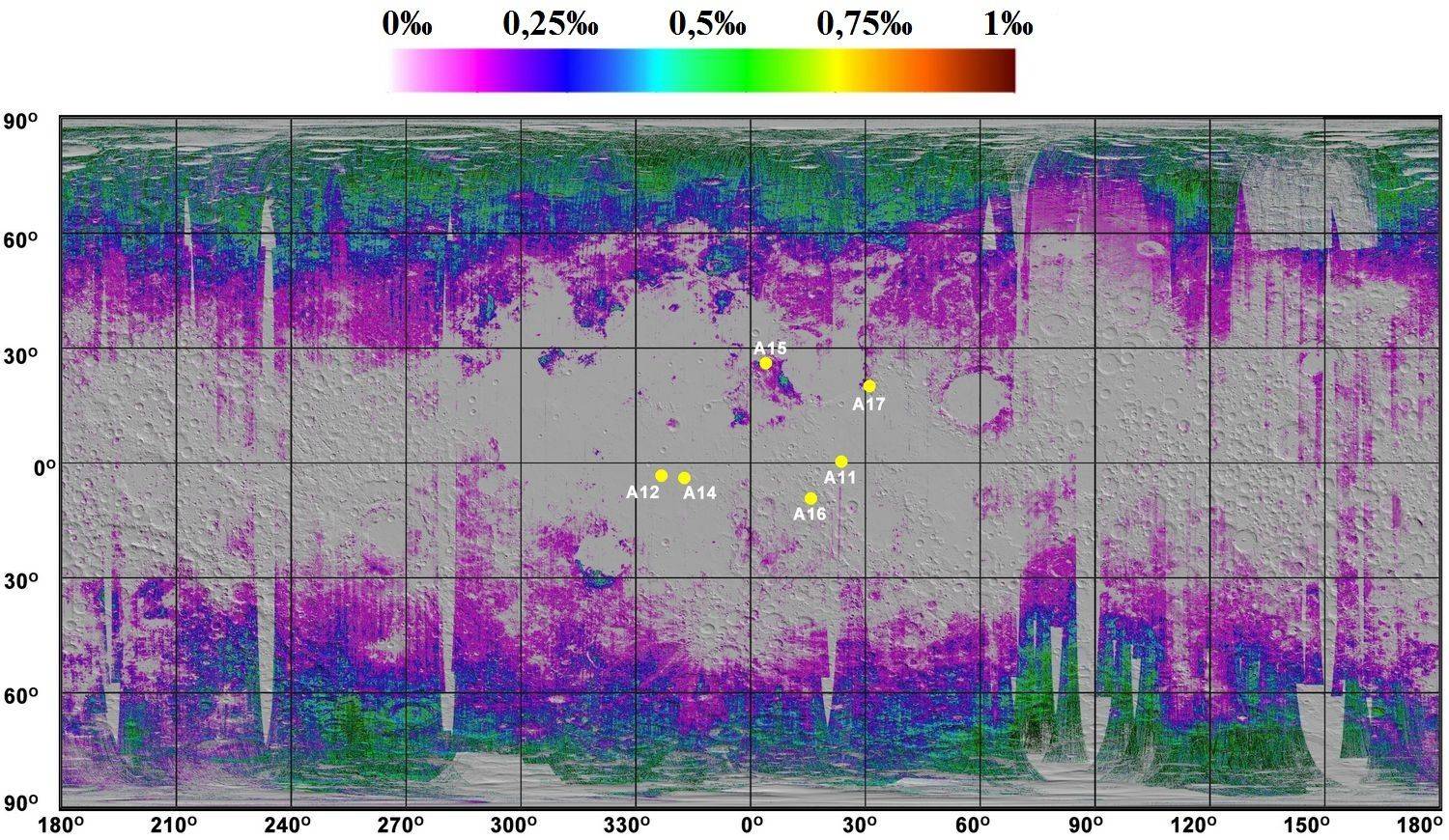
Venus
The next object, which hit the Earth's automatic probe, was Venus. She is called the "sister of the Earth" for the similarity in size and composition, but the conditions on its surface are radically different. The first device to enter the atmosphere of Venus was Venus-3 March 1, 1966. But due to underestimation of the monstrous pressure at the surface, the first apparatus was simply crushed during the descent. So only Venus-7 on December 17, 1970 managed to be unharmed on the surface. Within 20 minutes, the device managed to transmit data, according to which the surface temperature was about 475 ° C, and the pressure was about 90 atmospheres.
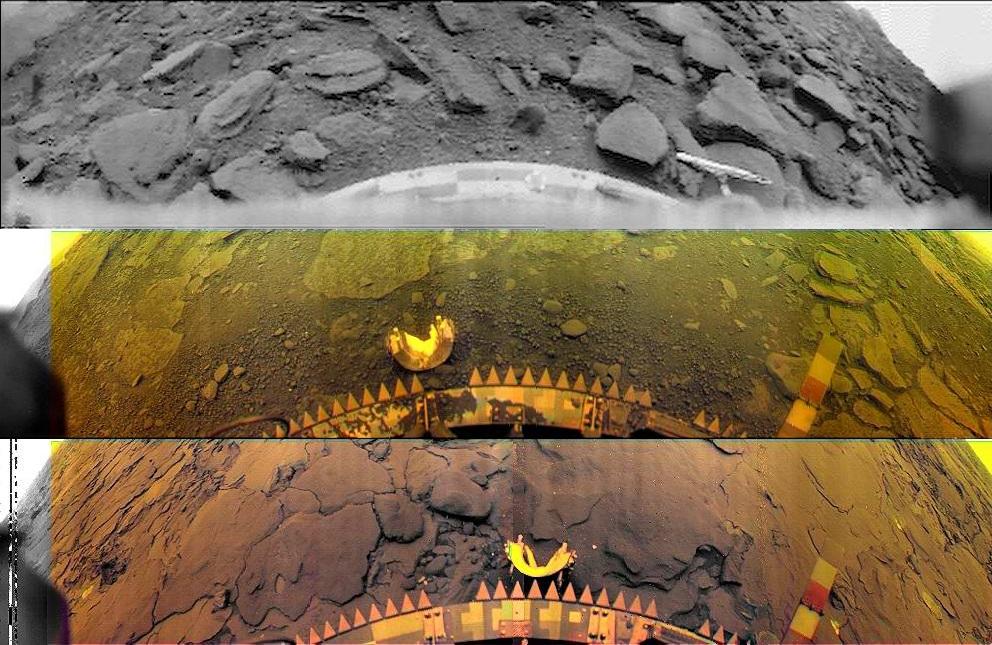
Pictures taken from the planet with Venus-9, 13 and 14 probes (the landings took place on October 22, 1975, and also on March 1 and 5, 1982).
Venus-9 was able to land on October 22, 1975 on the planet’s surface and transmit the first pictures from its surface. However, the data obtained by the first landing craft virtually excluded the possibility of detecting life on Venus, thereby reducing the ardor for exploring this planet. The final visit to the Venusian surface went to the Vega-2 lander, which landed there on June 15, 1985. Since then, studies of Venus have been conducted only from its orbit and with much less enthusiasm.
And then we learned that Venus and Earth still have much more in common than the first studies showed. The Galileo probe flying past Venus managed to detect granite and other rocks on it, which are formed on the Earth with the participation of water, indicating the presence of open water in the past on a neighboring planet. However, Magellan, which had flown to Venus a little earlier, made a radar map of almost the entire surface of the planet for several years and established that there has been virtually no erosion there lately. This suggests that about 500 million years ago, under the influence of sunlight, all water on Venus dissociated into oxygen and hydrogen, after which almost all of the hydrogen from the atmosphere was carried away by the solar wind.
Now Venus is a real hell with hurricane winds of 300 km / h in the upper atmosphere, clouds and rains of sulfuric acid in the middle layers, and monstrous pressure and temperature in the lower layers. But now we know for certain that this was not always the case, and once in the past Venus really resembled the Earth. Among other things, with the help of the Venus Express probe, thunderstorms traveling about 10 minutes a day were discovered on the planet, as well as a giant double atmospheric whirlwind in the South Pole, which collapses and reappears about every 2 days.
Mars
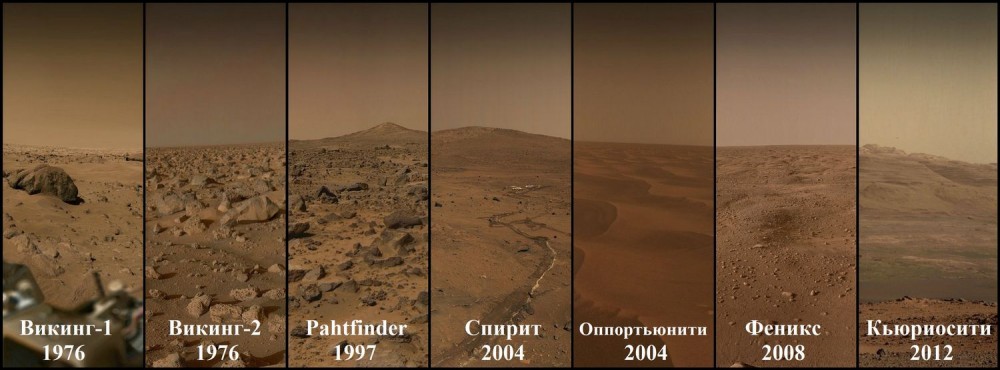
Our idea of Mars has also changed dramatically: at the beginning of the ordinary planet of the solar system, on which Giovanni Schiaparelli discovered many channels in 1877, it turned into a haven for a dying civilization from the works of “War of the Worlds” by Herbert Wells and “Aelit” by Alexei Tolstoy. But after the Mariner-9 probe entered Mars’ orbit in 1971, it turned out that all the channels discovered by Schiaparelli were just an optical illusion, and in the eyes of the average man Mars quickly turned into a lifeless planet from the works of Cyrus Bulychev:
Shelezyak planet: there are no minerals, there is no water, it is inhabited by robots.
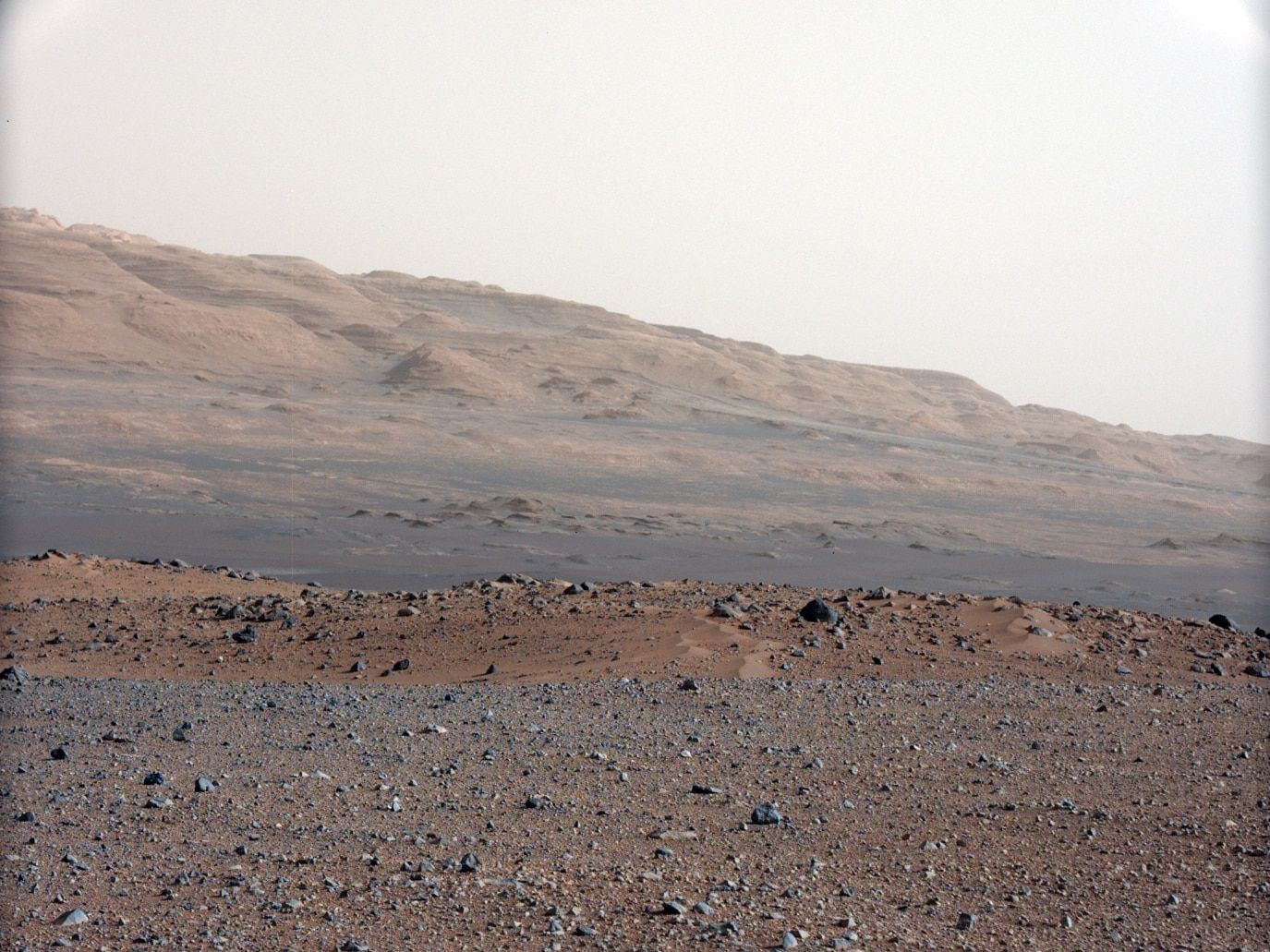
View of the base of Mount Sharpe from the Curiosity rover.
But besides the lifeless wastelands, Mariner-9 also discovered something very interesting - instead of artificial channels, the channels of ancient rivers were visible on the planet’s images. Scientists have suggested that they formed on Mars in the first few hundred million years, which turned out to be true in general. But as it became known later thanks to the MAVEN probe, liquid water was on the red planet another 1 billion years ago. And even earlier, about 4 billion years ago, there was an ocean on the planet comparable in size to the terrestrial Atlantic, which occupied almost the entire northern hemisphere. At that time there was so much water on Mars that if it could be distributed evenly over the entire surface, the depth would be 140 meters! And even now, water supplies could cover the planet with a layer of 35 meters.
This misconception regarding Mars did not end there. When the Viking-1 landing platform took the first color images from the surface of Mars, NASA immediately published them, but then the scientists of the project crept into doubt about the correctness of the calibration of its cameras, and they decided to “fix” the images by making them more red. It took a few more missions, so that scientists eventually came to understand the real colors of the surface and sky on Mars, and with all the NASA missions, special colored plastics are sent to Mars on Mars to calibrate the cameras right on the spot, to prevent such misunderstandings in the future.
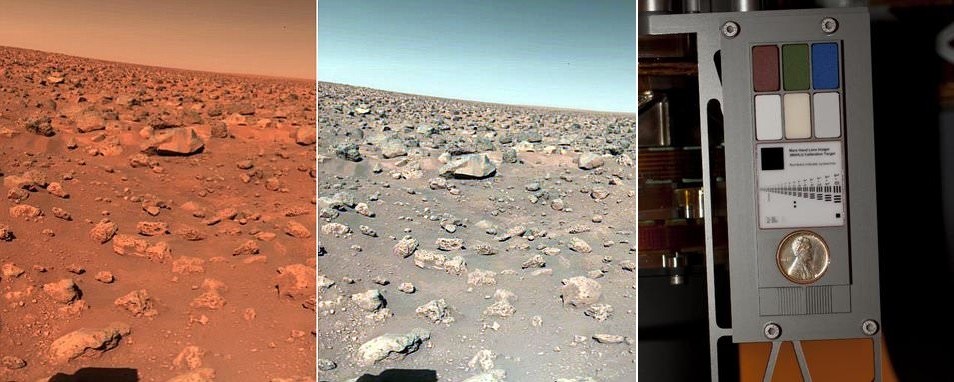
The first color image from Mars, its “corrected” version and the calibration plate of the Curiosity rover.
As a result, it turned out that the sky and soil on Mars are not as red as was supposed at the beginning, and the sunsets there are completely blue because of the dust suspended in the atmosphere, which reflects red light to a greater degree and gives the planet a “signature” shade. Due to the low density of the atmosphere, which is on average 0.61% of the Earth’s and reaching only 1.24% in the deepest part of the Hellas Plain, the temperature differences on Mars are noticeably greater than on Earth: the temperature there reaches -143 ° C at the poles in winter and 35 ° C at the equator in the summer, with an average planet temperature of about -46 ° C. The atmosphere is 95% carbon dioxide, also containing a couple of percent nitrogen and argon, as well as trace amounts of oxygen, carbon monoxide and water vapor.

Sunset on Mars on April 15, 2015 with a view of the Mastcam camera of the Curiosity rover. 4 gif pictures were taken within 7 minutes.
Thanks to the probes and rovers sent to the planet, we now know that in most of Mars near the surface, the concentration of water ice exceeds 10%, thunderstorms periodically occur there, thin clouds can form at night and even fine snow will fall . However, most of the time the surface of the planet resembles a lifeless desert, in which only dust storms occur.
Although erosion on Mars effectively gets rid of sharp and dangerous dust particles for humans, another source of danger remains on the planet - the presence of perchlorates in the soil. At low concentrations, they are harmless, but at concentrations existing in Martian soil, they can inhibit the human thyroid gland and plant growth. Thus, as in the case of the Moon, water and soil cannot be used directly, although the form of their cleaning will be much simpler than in the case of the Moon. But there is much more water on Mars than on the Moon, and it is present almost everywhere in the soil.

Jupiter
Jupiter is a gas giant - a huge planet consisting mostly of light gases like hydrogen and helium. With depth, pressure rises, and gases liquefy and possibly even turn into a solid in the core of the planet (the structure of the core of Jupiter is still not known reliably ). So it’s simply impossible for the earth’s apparatus to reach such depths due to monstrous pressures and temperatures. However, the entry into the atmosphere of Jupiter and the study of its upper layers are technically possible, and this was already done on December 7, 1995 during the Galileo mission.
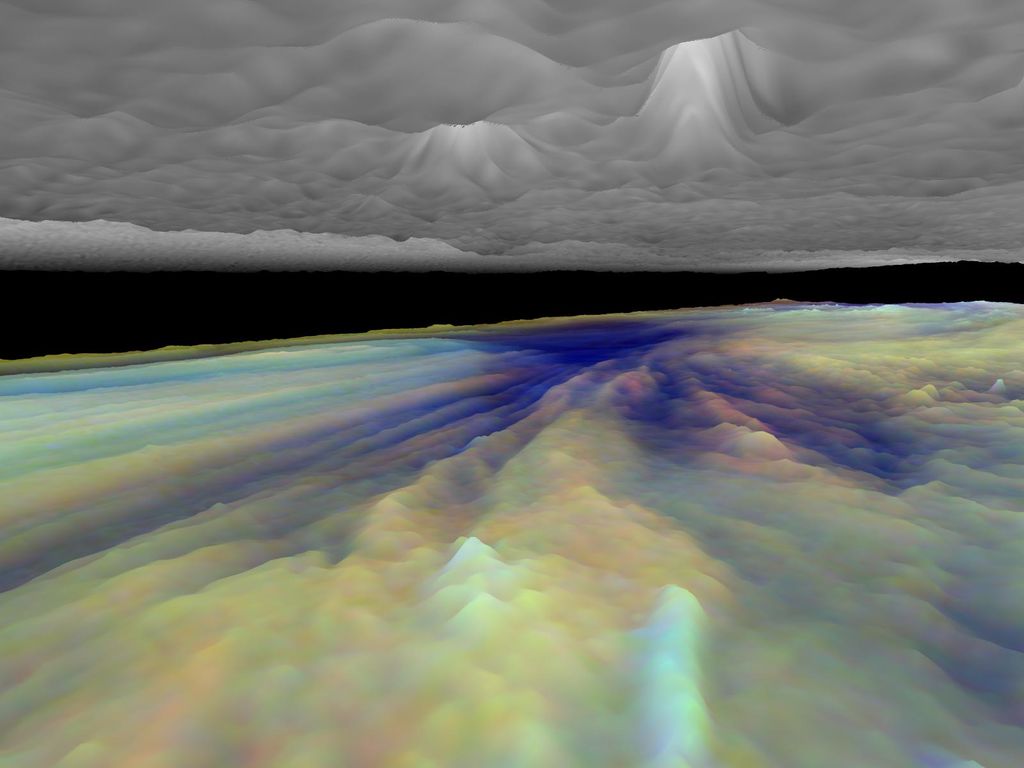
Three-dimensional map of Jupiter's clouds according to Galileo.
The huge gravity of Jupiter made this task insanely difficult: the descent vehicle had to enter the atmosphere at a speed of 47.8 km / s, and peak loads reached 228g. In order not to melt under the influence of the oncoming flow, the temperature of which reached 15.5 thousand degrees, out of 339 kg of the total mass of the apparatus, as much as 152 kg accounted for a heat shield, of which 80 kg simply evaporated during braking. After braking in the atmosphere, the descent vehicle dropped the remnants of the heat shield, opened a 2.5-meter parachute and descended for another 58 minutes, transmitting data to the Galileo main probe.
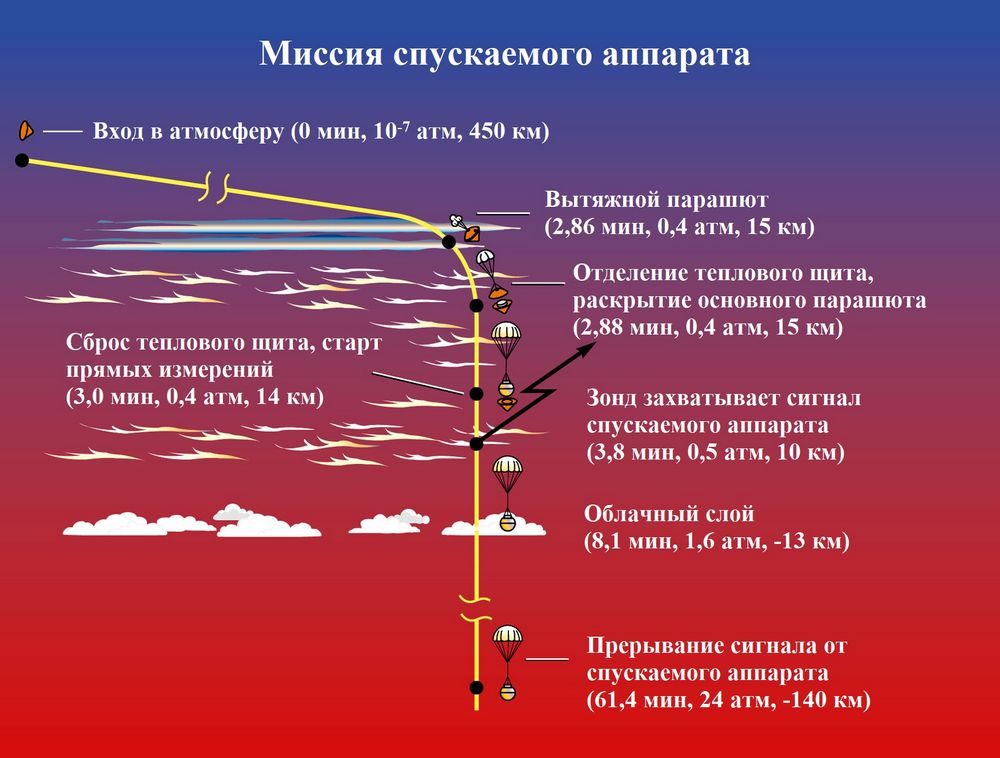
The device managed to fix the pressure up to 23 atmospheres and a temperature of 153ºC, after which it failed. Unfortunately, there were no cameras on it. It was assumed that the device would still be able to see only cloudy haze, and it is unlikely that we would be able to get these pictures - in total Galileo transmitted only less than half a megabyte of data on atmospheric pressure, temperature and wind speed. But even without the images, the information obtained was very interesting: the temperature and pressure measured by the probe were higher than expected, the concentration of water and the frequency of thunderstorms were lower, and the helium content was about 2 times less than expected. The wind speed in the outer layers was consistent with the models, and amounted to 290-360 km / h. But in the lower layers (at atmospheric pressure in the range of 1-4 atmospheres), the wind accelerated sharply to about 610 km / h and remained so throughout the rest of the descent to a depth of 160 km.
Asteroid Eros

Pictures of an asteroid from a distance of 1150, 700, 250 and 120 meters, having sides with a resolution of 54, 33, 12 and 6 meters, respectively.
On February 12, 2001, the NEAR Shoemaker probe became the first terrestrial vehicle to land safely on an asteroid. And although it was not originally intended for this, the device was able to land on an asteroid due to low gravity, which was about 1.5 thousand times less than Earth's. For its mission, by that time, the device received more than 160 thousand images of this asteroid, but he could no longer take photos from the surface. But thanks to the landing, it turned out to conduct a more accurate chemical analysis of the surface of Eros. There were discovered magnesium, aluminum, silicon, sulfur, calcium, chromium and iron. Due to the lack of atmosphere, the temperature on the asteroid changed almost as sharply as on Mercury: during the day it could rise to 100ºC, and at night it could drop to -150ºC. According to the data obtained, scientists were also able to establish that Eros is a very ancient object, and most likely formed about 4.6 billion years ago during the formation of the solar system itself.
Titanium

Titanium is the only satellite among the solar system that has a dense atmosphere - the atmospheric pressure at its surface is 1.45 times higher than Earth's. The distance from the Sun, which is 9-10 times greater than that of the Earth, coupled with dense clouds hiding the surface of the satellite from the earth's observer, lead to the fact that only 1/3000 of that light that reaches the surface of the Earth reaches the surface of Titan. Thanks to the Huygens probe, we have learned that, like on Earth, rivers flow on Titan and it rains. True, all because of the same problem with a small amount of light, rains are rare here. But the most interesting thing is that because of the terribly low temperatures (and near the surface it is about -179 ° C), the role of a liquid on Titan is not water at all, but methane mixed with other hydrocarbons!
In fact, the lakes on Titan and the clouds in its atmosphere are similar in composition to terrestrial natural gas, on which we cook and refuel cars. However, one should not be afraid of explosions and fires on this satellite, because there is practically no free oxygen in its atmosphere: almost entirely (by 98.4%) it consists of nitrogen. The average methane content in the atmosphere is 1.4%, but starting from the lower layers of the troposphere and to an altitude of 8 km, its concentration rises to 4.9%. In addition, hydrogen occupies 0.2%, and trace amounts of ethane, propane, diacetylene, propine, helium, argon, carbon dioxide and carbon monoxide, cyan, cyanoacetylene, and even hydrocyanic acid are also found .

Studies have shown that comets from the Oort cloud come from the source of nitrogen in the atmosphere of Titan, and the ratio of hydrogen and deuterium isotopes ( 1 H / 2 H) suggests that the atmospheric hydrogen of Titan has a different origin. In addition, it is not entirely clear where the methane comes from in the atmosphere, whose ions give it a “signature” yellowish tint. The ions themselves are formed during the decomposition of methane into parts under the influence of ultraviolet radiation from the sun. Calculations show that because of this process, in just 50 million years, all methane in the atmosphere of Titan was supposed to turn into polyaromatic hydrocarbons (their appearance was one of the key steps in the origin of life on Earth). But since methane has not yet disappeared, scientists consider this an indirect confirmation of the existence of cryovolcanism on Titan, the source for which may be tidal heating under the influence of gravity of Saturn and its other satellites.
The dense atmosphere protects Titan well from the small bodies of the solar system - only a few impact craters are found on its surface. In addition, the dense atmosphere, coupled with low gravity (1/7 of the Earth's), led to the Huygens probe taking as long as 2.5 hours to descend through the atmosphere. Theoretically, such conditions make you feel like a real Daedalus: if someday humanity manages to create a sufficiently light spacesuit for such conditions, then by attaching wings to it a person will be able to fly there like a bird.
Comet Tempel

For the first time, the Deep Impact apparatus managed to come into contact with a comet on July 4, 2005. True, this touch was truly harsh: during a collision of a 370-pound device with Tempel’s comet at a speed of 10.2 km / s. energy equivalent to the explosion of 4.8 tons of dynamite was released.The event was carried out intentionally so that the main apparatus flying along with the shock probe could capture the emission of matter from the depths of the comet and analyze its composition.
Gas emissions from the comet lasted as long as 13 days after the collision, and their peak occurred only on the 5th day. As a result, the comet lost about 5 thousand tons of water and about 10-25 thousand tons of dust. This ratio surprised scientists, because they expected to see in the composition of most of the water ice than dust particles. Another surprise for them was that about 75% of the comet consisted of empty space that was not filled with matter. Since the quality of the images of the crater did not satisfy the scientists, another device, Stardust, was sent to meet this celestial body, which determined that the crater formed by the impact probe had as much as 150 meters in diameter!
Asteroid Itokawa

The first device created specifically for landing on an asteroid and returning soil from it was the Japanese "Hayabusa". This mission turned out to be generous with all kinds of malfunctions: during the first attempt at soil sampling (November 19, 2005), the probe first stopped executing commands, and then moved to “safe mode” during the ascent. On the 23rd, the attempt was repeated again, but the sequence of commands for taking soil did not work again, and it was possible to conduct it only on November 25th. However, already on November 27, the device again went into safe mode due to a fuel leak, which eventually led to its uncontrolled unwinding and loss of connection on December 8. It was possible to restore communication by March 7, 2006, but 2 out of 4 ion engines of the device did not work anymore, as did 4 out of 11 batteries. However, the sample container was sealed,and Hayabusa could in such a state go back.

The entry of the Hayabusa capsule with asteroid samples into the Earth’s atmosphere.
On April 25, 2007, she began to fly back, during which (August 29) she managed to restart another of the 4 ion engines, after which the flight took place almost without incident. On June 13, 2010, Hayabusa was finally able to deliver to the Earth about 1.5 thousand micrograins the size of 1/10 of the thickness of a human hair (10 microns).
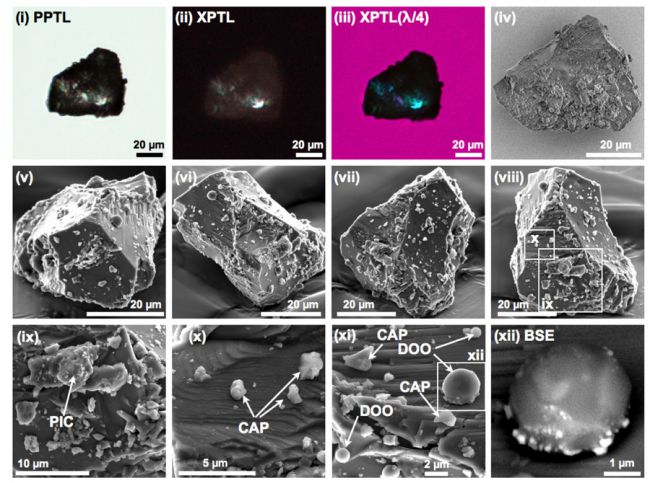
A number of samples obtained by Hayabusa.
According to the results, Itokawa was once part of a larger asteroid that collapsed in a collision with another object about 1.5 billion years ago. The obtained samples spent about 8 Ma on the surface of the asteroid and were minerals of the olivine and pyroxene types distributed on the Earth, the Moon, and Mars, and some of them were LL chondrites, which are found in meteorites.
Comet Churyumov-Gerasimenko
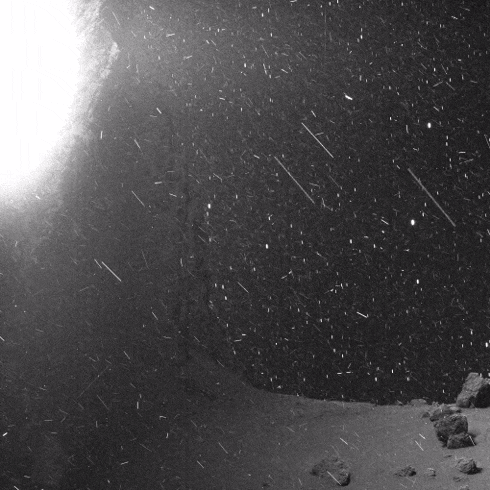
The first ever soft landing on a comet was made by the Philae probe, followed by the Rosetta main unit. Philae was not very lucky to land: the rocket engines that were supposed to hold him to the surface did not work. The harpoon was also unable to fix the probe, which is why the drills on the supports that would finally fix Philae to the surface were also useless. As a result, the probe bounced, flipped over the surface and fell into a crevice, where its solar panels could no longer supply it with energy. However, according to scientists from the Philae project, 80% of his research program was implemented .
According to the radar data, it turned out that the comet's porosity is 75-85%, but it is rather heterogeneous, because the shock probe has already hit hard ice at a depth of 3 cm. An analysis of the gases detected at the surface indicated the presence of methyl isocyanate, propionaldehyde, acetamide, acetone, formaldehyde, ammonia, and many other organic compounds and even methanol / ethanol. If a person could inhale the gas emitted from this comet, he would feel a terrible stench. And this composition is close to the so-called "primary broth" , from which life on Earth was supposedly born. Therefore, comets are considered one of its possible sources. The surface temperature varied over a wide range depending on the distance from the Sun: from 100 ° C on the illuminated side to-243 ° C on shaded.
Mercury
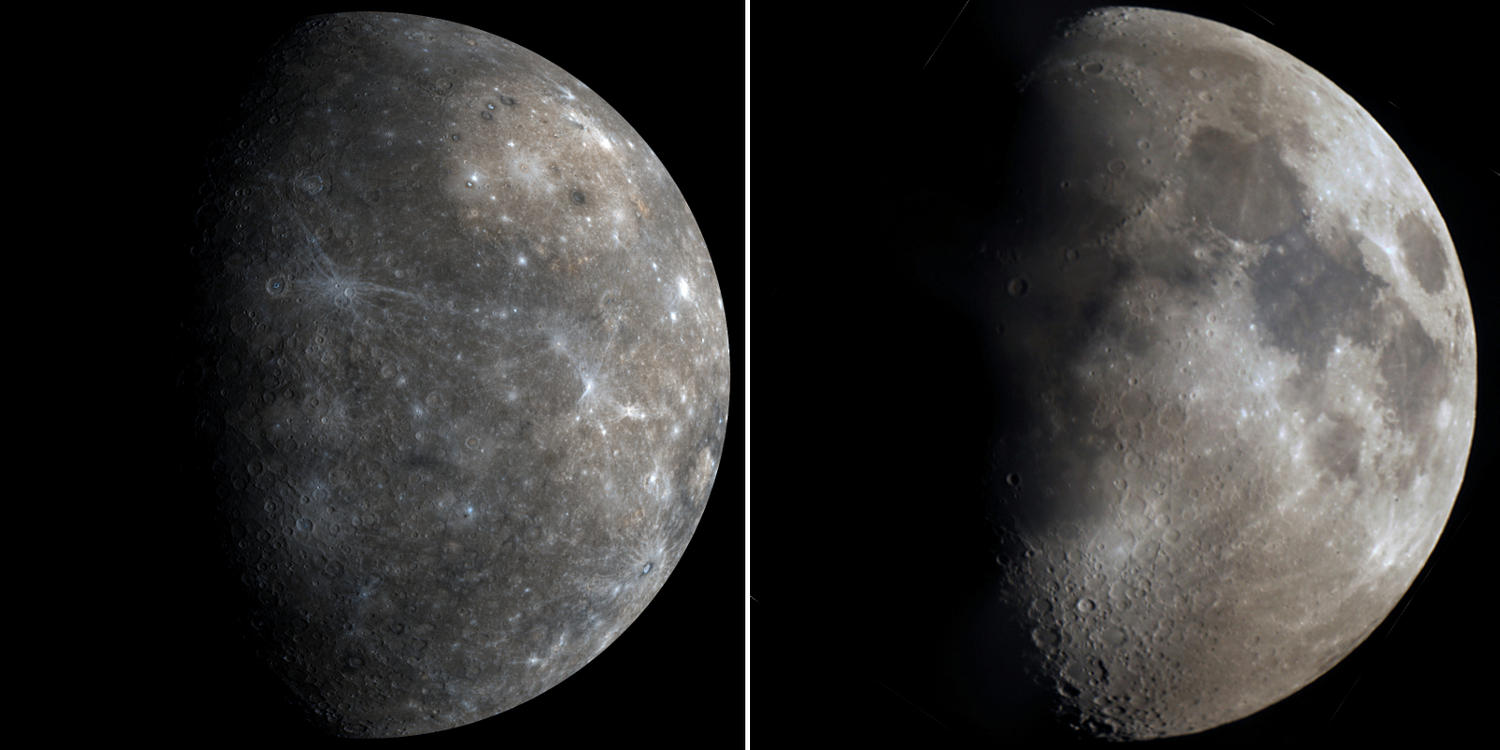
Comparison of Mercury (left) and the Moon (right) without taking into account scale (the Moon is about 1.4 times smaller in size than Mercury).
Mercury is also a very interesting place for research, but getting to it is more difficult for us than to any other object of the solar system. Therefore, there have not been soft landings on this planet yet, but it was tough when the Messenger probe crashed onto the surface of Mercury on April 30, 2015, completing its 4-year mission. According to NASA experts, the probe moved at a speed of 3.912 km / s at the moment of impact with the surface and formed a crater with a diameter of about 16 meters. In total, he managed to collect more than 270 thousand images and a whole set of scientific data.
Due to its proximity to the Sun and its very small mass, Mercury lost almost its entire atmosphere. Her pressure is about 10 -14from the earth, and the total mass is about 10 tons. This made the conditions on the planet’s surface very inhospitable: during the day the temperature on its surface rises to + 427 ° C (slightly less than on Venus), and at night it drops to -173 ° C (as on Titan). Although the attraction of the Sun affects Mercury very strongly, its rotation around its axis did not slow down to the orbital speed of rotation, but only turned out to be in resonance with it 2/3, due to which the solar day on Mercury is about 176 Earth. In addition, the planet closest to the Sun is famous for one of the largest craters in the Solar System with a diameter of as much as 1,500 km, the formation of which required energy equivalent to a quadrillion tons of trotillus!
It used to be that volcanism on Mercury ceased 3.5 billion years.back - much earlier than the moon. However, the Messenger was able to establish that the last traces of geological activity on the planet date back only 50 million years . In addition, in 2012, water ice was discovered in regions near the poles of Mercury, where sunlight never reaches. The conclusion is sad: the life that we know is unlikely to exist in such conditions.
Saturn

September 14, 2017 at 22:59 Moscow time, the Cassini probe took this picture from a distance of 634 thousand km from Saturn, after which the connection with it was cut off. Image resolution is about 17 km per pixel.
"Cassini" was not designed to enter the atmosphere of Saturn and was sent there solely to prevent possible contamination of its satellites by terrestrial microorganisms that could theoretically survive the probe’s almost 20-year mission. At the same time, the device collected a lot of information about Saturn. For example, a day on this planet lasts 10 hours and 33.5 minutes, and the deviation of the axis of rotation from the axis of the magnetic field is only 0.01º. He also managed to record the sounds that the magnetic field of the gas giant "made", and to study near the "hexagon of Saturn" - a giant storm at the north pole.
Asteroid Ryugu
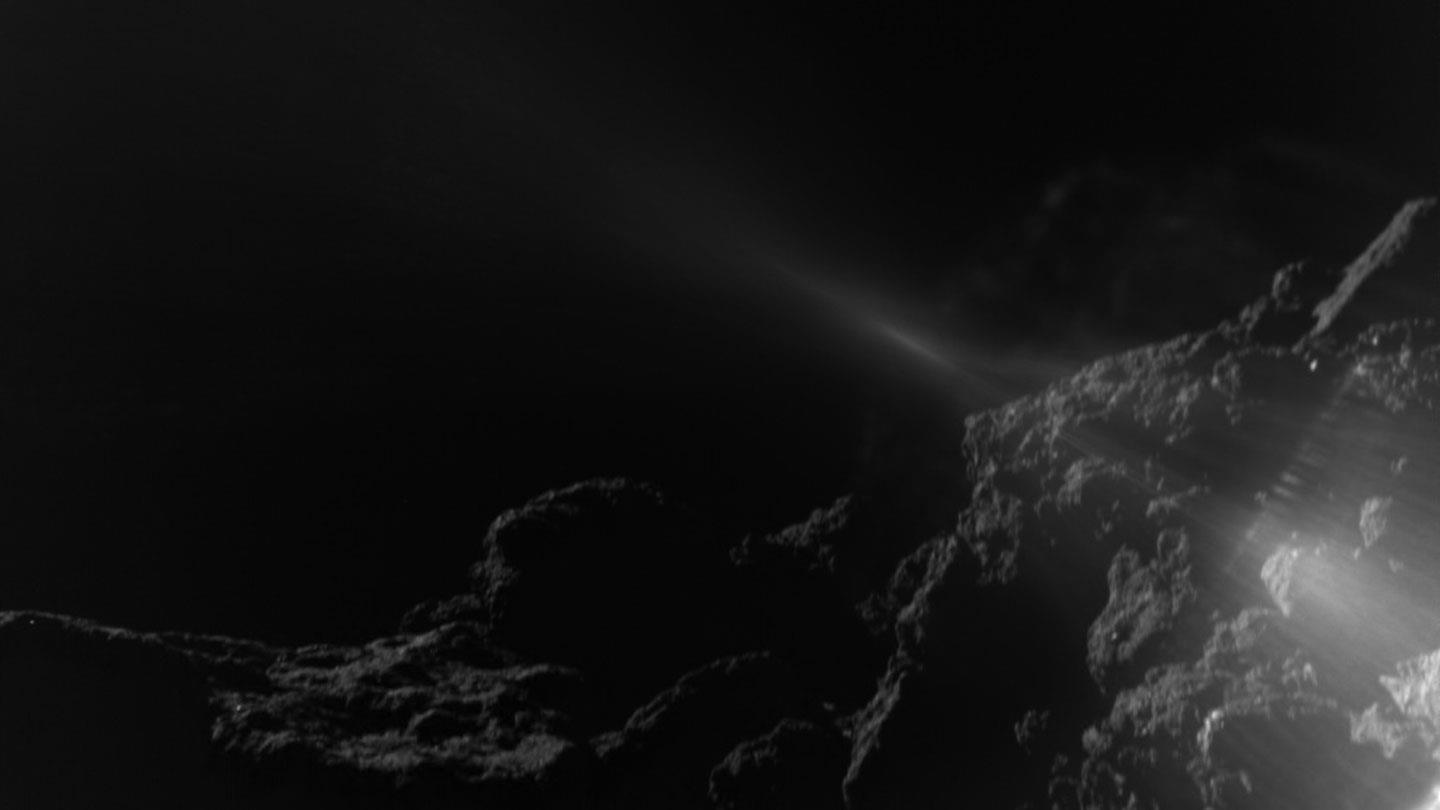
MASCOT probe image from the surface of an asteroid.
On February 21 of this year, the second landing on an asteroid took place. The mission went to the Japanese Hayabusa-2 apparatus. This time, not one landing vehicle flew with him, but four at once: Rover-1A and Rover-1B from JAXA and Aizu University, Rover-2 from Tohoku University and MASCOT from the old cooperation of the German space agency DLR and the French CNES. At the moment, the device has already carried out soil sampling and discharges of landing vehicles, and is now preparing to travel towards the Earth. Now scientists are only processing the data, and the capsule with samples of Hayabusa-2 soil will be dropped to Earth only at the end of next year. Therefore, at the moment we are waiting for new information about this asteroid.
Asteroid bennu
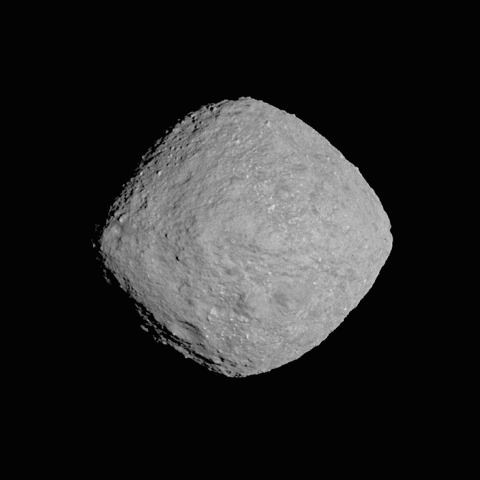
The asteroid Bennu should become the next celestial body on which the Earth’s vehicle will sit: the OSIRIS-REx probe is currently landing on an asteroid for soil collection on July 4 next year, and its delivery to Earth is due on September 24, 2023.
Symphony Orchestra on the Outskirts of the Universe
Although we were not able to get pictures and sounds directly from the atmospheres of the giant planets, but thanks to a pair of Voyagers, we were able to record those sounds that emit their magnetic fields. But more interesting were those sounds that other objects emit - neutron stars:
The composer's art of the Universe was not very impressive, but it was clearly not deprived of a "sense of rhythm."
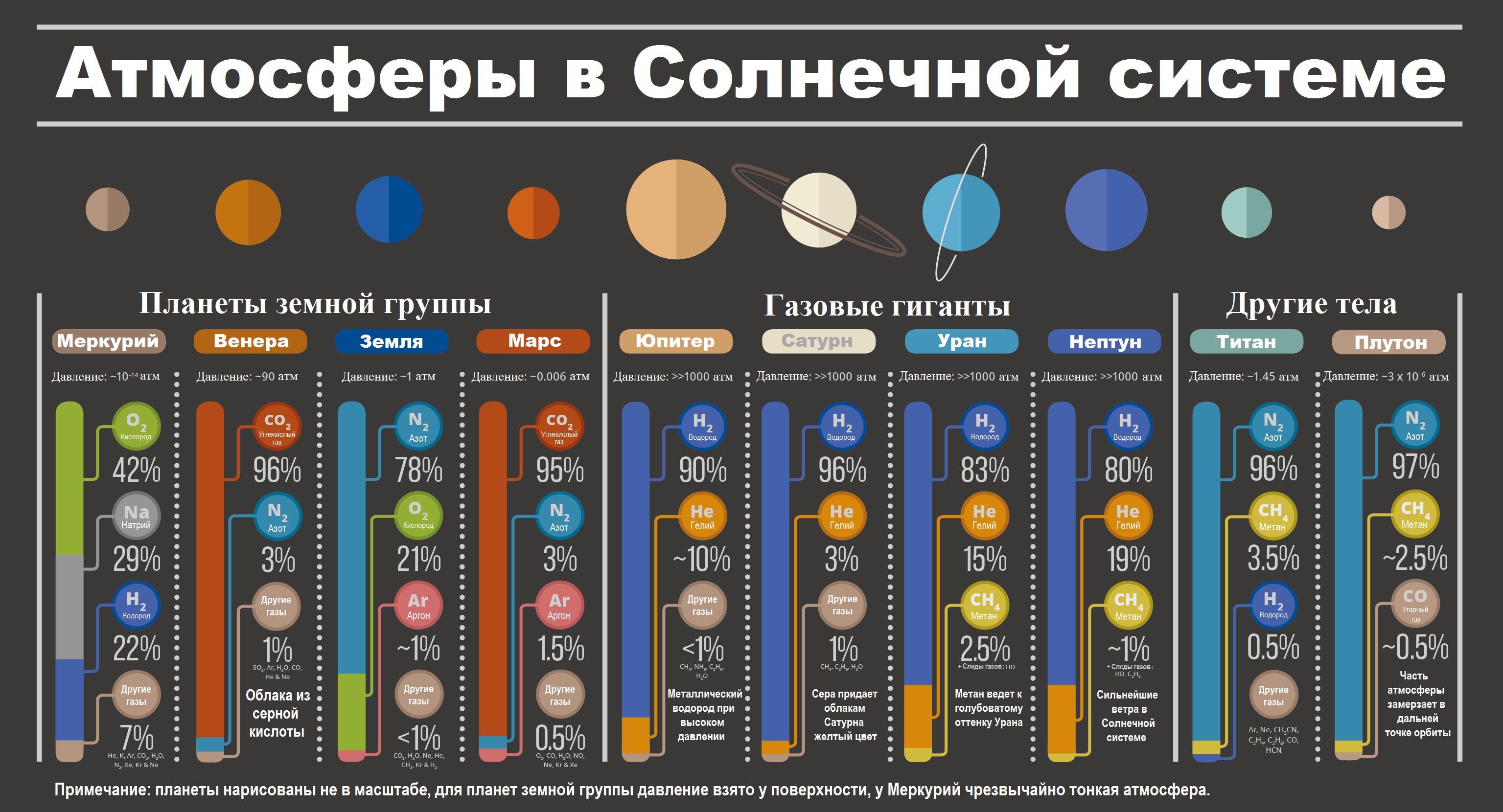
Studies have shown that the fate of the gas giants turned out to be similar, while the development of the terrestrial planets varies greatly, although they began their evolution from similar states. For us, perhaps the most important discovery was that in the solar system there was not a single as comfortable place to live as the Earth is.
Many now say that astronautics prevent us from concentrating on earthly problems, but in reality this is not so at all. This is what Neil Degrass Tyson noted when commenting on the results of the Apollo program: in 1970, Earth Day was first celebrated, which later became international, in the United States acts on clean water and air were adopted in the United States in 1971-1973, and the National Oceanic and Atmospheric Administration ( NOAA ) and the United States Environmental Protection Agency ( EPA ) were also formed in 1970 . In 1972, the United States banned the insecticide DDT and tetraethyl lead as an additive to fuel, and in 1973 catalytic converters (reducing harmful emissions into the atmosphere) appeared, the installation of which became mandatory for most cars already in 1975.
“Just by going to the moon and looking back from there, we first discovered the Earth for ourselves.”
All Articles